story and photos by Kayte Deioma
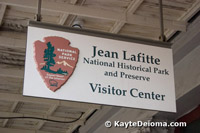 The Jean Lafitte National Historic Park and Preserveconsists of parks, preserves, bayous, swamps, historic sites and cultural centers all across southern Louisiana. In New Orleans, the National Historic Park has a French Quarter Visitor Center tucked in a courtyard off Decatur Street. If you want an in depth look at New Orleans and Louisiana history, go to the Cabildo on Jackson Square, but for an easily digestible overview of the city and its music, the Jean Lafitte NHP French Quarter Visitor Center is the place to go.
The Jean Lafitte National Historic Park and Preserveconsists of parks, preserves, bayous, swamps, historic sites and cultural centers all across southern Louisiana. In New Orleans, the National Historic Park has a French Quarter Visitor Center tucked in a courtyard off Decatur Street. If you want an in depth look at New Orleans and Louisiana history, go to the Cabildo on Jackson Square, but for an easily digestible overview of the city and its music, the Jean Lafitte NHP French Quarter Visitor Center is the place to go.
The Visitor Center presents an overview of what you will find at all six of the Jean Lafitte NHP centers including Chalmette Battlefield and the Barataria Preserve in the New Orleans area, and the Acadian Cultural Center, Prairie Acadian Cultural Center and Wetlands Acadian Cultural Center across the Mississippi delta.
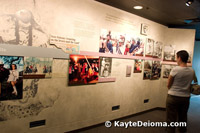 Traditional exhibits include background on the Native Americans of Louisiana, slave life, and the contribution of privateer and slave trader Jean Lafitte at the Battle of New Orleans, as well as the legend of Voodoo priestess Marie Laveau. Wall panels and audio recordings elucidate the development of the unique dialect of New Orleans, influenced by African slaves, and French, Irish, Italian and German immigrants, with some Native American place names thrown in for good measure.
Traditional exhibits include background on the Native Americans of Louisiana, slave life, and the contribution of privateer and slave trader Jean Lafitte at the Battle of New Orleans, as well as the legend of Voodoo priestess Marie Laveau. Wall panels and audio recordings elucidate the development of the unique dialect of New Orleans, influenced by African slaves, and French, Irish, Italian and German immigrants, with some Native American place names thrown in for good measure.
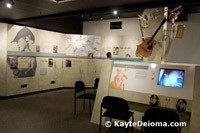 Pull up a chair and stay for a while at a multimedia presentation on the history of jazz. Put on a hea
Pull up a chair and stay for a while at a multimedia presentation on the history of jazz. Put on a hea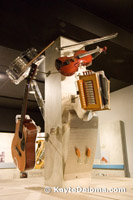 dset and watch and listen to some historic performances. A selection of instruments used in jazz, Cajun and Zydeco music are suspended from a column above the video console. There’s a brass trumpet, and saxophone, a guitar, a fiddle, and an accordion. The most unique instrument on display is the “frottoir” or rubboard, a molded, over-the-shoulder Louisiana invention which replaced the standard wood-frame washboard in Cajun and Zydeco music in 1946.
dset and watch and listen to some historic performances. A selection of instruments used in jazz, Cajun and Zydeco music are suspended from a column above the video console. There’s a brass trumpet, and saxophone, a guitar, a fiddle, and an accordion. The most unique instrument on display is the “frottoir” or rubboard, a molded, over-the-shoulder Louisiana invention which replaced the standard wood-frame washboard in Cajun and Zydeco music in 1946.
A few feet away you can take a seat on a bench to watch another video on a larger screen. The selection varies. After Hurricane Katrina, a new exhibit was added on the storm flooding and how the loss of wetlands contributed to the problem. Park Rangers are on hand to answer your questions.
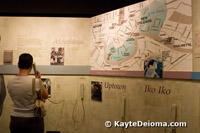 There are a couple other reasons why you might want to visit the Jean Lafitte National Historic Park French Quarter Visitor Center. It’s a good place to find public restrooms if you’re wandering the French Quarter. They also offer free 90-minute French Quarter tours daily at 9:30 am. Tickets are distributed to the first 25 people who show up for tickets after the Center opens at 9. There is a schedule of additional presentations and programs on the website.
There are a couple other reasons why you might want to visit the Jean Lafitte National Historic Park French Quarter Visitor Center. It’s a good place to find public restrooms if you’re wandering the French Quarter. They also offer free 90-minute French Quarter tours daily at 9:30 am. Tickets are distributed to the first 25 people who show up for tickets after the Center opens at 9. There is a schedule of additional presentations and programs on the website.
Jean Lafitte National Historic Park
French Quarter Visitor Center
419 Decatur Street
New Orleans, LA
504-589-2636 ext. 1
Open daily 9:00 a.m.-5:00 p.m.
Closed December 25 and Mardi Gras
http://www.nps.gov/jela/index.htm

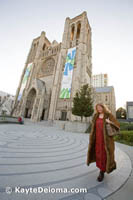 For a quick “time out” from the hustle and bustle of the city, head up Nob Hill to Grace Cathedral for a peaceful half hour of self-exploration on either of the two labyrinths on site. Labyrinths have been used as a tool for walking meditation in many cultures and religions for thousands of years. The deliberate path of spirals confined within a circle represents the journey of life. Grace Cathedral, the Bishop’s seat of the Episcopal Church of California,
For a quick “time out” from the hustle and bustle of the city, head up Nob Hill to Grace Cathedral for a peaceful half hour of self-exploration on either of the two labyrinths on site. Labyrinths have been used as a tool for walking meditation in many cultures and religions for thousands of years. The deliberate path of spirals confined within a circle represents the journey of life. Grace Cathedral, the Bishop’s seat of the Episcopal Church of California,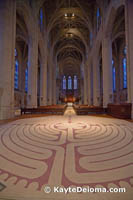 began construction in 1906 after the earthquake and fire and was finally completed in 1966. The Cathedral’s two labyrinths, added in the mid-1990s, replicate the design built into the floor of the Chartres Cathedral in France around the year 1220.
began construction in 1906 after the earthquake and fire and was finally completed in 1966. The Cathedral’s two labyrinths, added in the mid-1990s, replicate the design built into the floor of the Chartres Cathedral in France around the year 1220.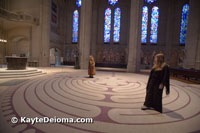 There are generally considered to be three phases to the walking meditation. The way from the outside of the circle to its center is the Purgation or releasing, where you let go of the distracting details of your life to quiet your mind and open yourself.
There are generally considered to be three phases to the walking meditation. The way from the outside of the circle to its center is the Purgation or releasing, where you let go of the distracting details of your life to quiet your mind and open yourself.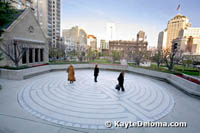 The indoor labyrinth is available only when the Cathedral is open to the public and is not having regular services, a wedding or other special events. There is also an outdoor terrazzo stone labyrinth at the front right corner of the church that is always open.
The indoor labyrinth is available only when the Cathedral is open to the public and is not having regular services, a wedding or other special events. There is also an outdoor terrazzo stone labyrinth at the front right corner of the church that is always open.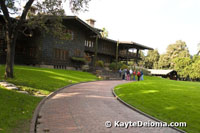 You can’t decide at the spur of the moment that you’d like to tour JPL, but you can look at those rain-bearing clouds and opt for an hour inside the cozy confines of the Gamble House. You don’t really visit the Gamble House to learn about the history of the Gamble family, of the Cincinnati-based Procter & Gamble Company, who summered here. The Gamble House is a masterwork of architects Henry and Charles Greene, who also built many other Arts and Crafts Movement houses in the area.
You can’t decide at the spur of the moment that you’d like to tour JPL, but you can look at those rain-bearing clouds and opt for an hour inside the cozy confines of the Gamble House. You don’t really visit the Gamble House to learn about the history of the Gamble family, of the Cincinnati-based Procter & Gamble Company, who summered here. The Gamble House is a masterwork of architects Henry and Charles Greene, who also built many other Arts and Crafts Movement houses in the area.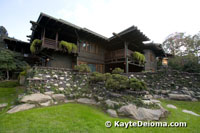 Commissioned in 1907 by David B. and Mary Gamble, the Gamble house incorporates Swiss and Japanese aesthetics and an Arts and Crafts philosophy into a quintessentially California structure. Long eaves shelter the house from the sun. Sleeping porches take advantage of cool evening breezes. Natural redwood shakes covering the exterior were designed to blend with the rustic Arroyo setting that surrounded the house before the area was developed.
Commissioned in 1907 by David B. and Mary Gamble, the Gamble house incorporates Swiss and Japanese aesthetics and an Arts and Crafts philosophy into a quintessentially California structure. Long eaves shelter the house from the sun. Sleeping porches take advantage of cool evening breezes. Natural redwood shakes covering the exterior were designed to blend with the rustic Arroyo setting that surrounded the house before the area was developed.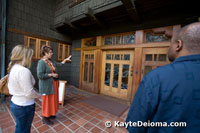 Hour-long docent-led tours begin on the side terrace and take you through the three-panel front door. The panels are adorned with leaded stained glass patterned with oak tree trunks and ginkgo leaves designed by Charles Greene, the more artistic brother. Charles also designed most of the furnishings in the house.
Hour-long docent-led tours begin on the side terrace and take you through the three-panel front door. The panels are adorned with leaded stained glass patterned with oak tree trunks and ginkgo leaves designed by Charles Greene, the more artistic brother. Charles also designed most of the furnishings in the house.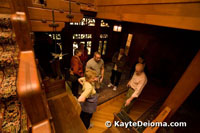 The first thing you notice inside the house is how dark it is. Although the house was built with electricity, the bulbs are very dim and the walls throughout are of dark wood. Our guide uses a flashlight to point out the smooth joinery and the rounded corners and edges on all the Burma teak features and furnishings in the entry hall.
The first thing you notice inside the house is how dark it is. Although the house was built with electricity, the bulbs are very dim and the walls throughout are of dark wood. Our guide uses a flashlight to point out the smooth joinery and the rounded corners and edges on all the Burma teak features and furnishings in the entry hall.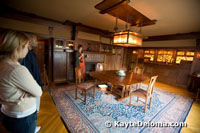 in the neighboring butler’s pantry and servants’ dining porch show just as much attention to detail as in the parts of the house inhabited by the family.
in the neighboring butler’s pantry and servants’ dining porch show just as much attention to detail as in the parts of the house inhabited by the family.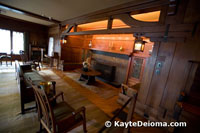 There are two single beds in the master bedroom and one double bed in the boys’ room. The boys are reported to have slept out on the sleeping porch, since they only visited the house on summer breaks from boarding school.
There are two single beds in the master bedroom and one double bed in the boys’ room. The boys are reported to have slept out on the sleeping porch, since they only visited the house on summer breaks from boarding school.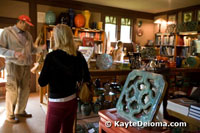 The tour exits downstairs through Mr. Gambles den and back out to the terrace, from where you can explore the small garden or make your way to the Bookstore in the former garage. A walking tour map of other Greene and Greene houses in the neighborhood is available for purchase in the Bookstore.
The tour exits downstairs through Mr. Gambles den and back out to the terrace, from where you can explore the small garden or make your way to the Bookstore in the former garage. A walking tour map of other Greene and Greene houses in the neighborhood is available for purchase in the Bookstore.